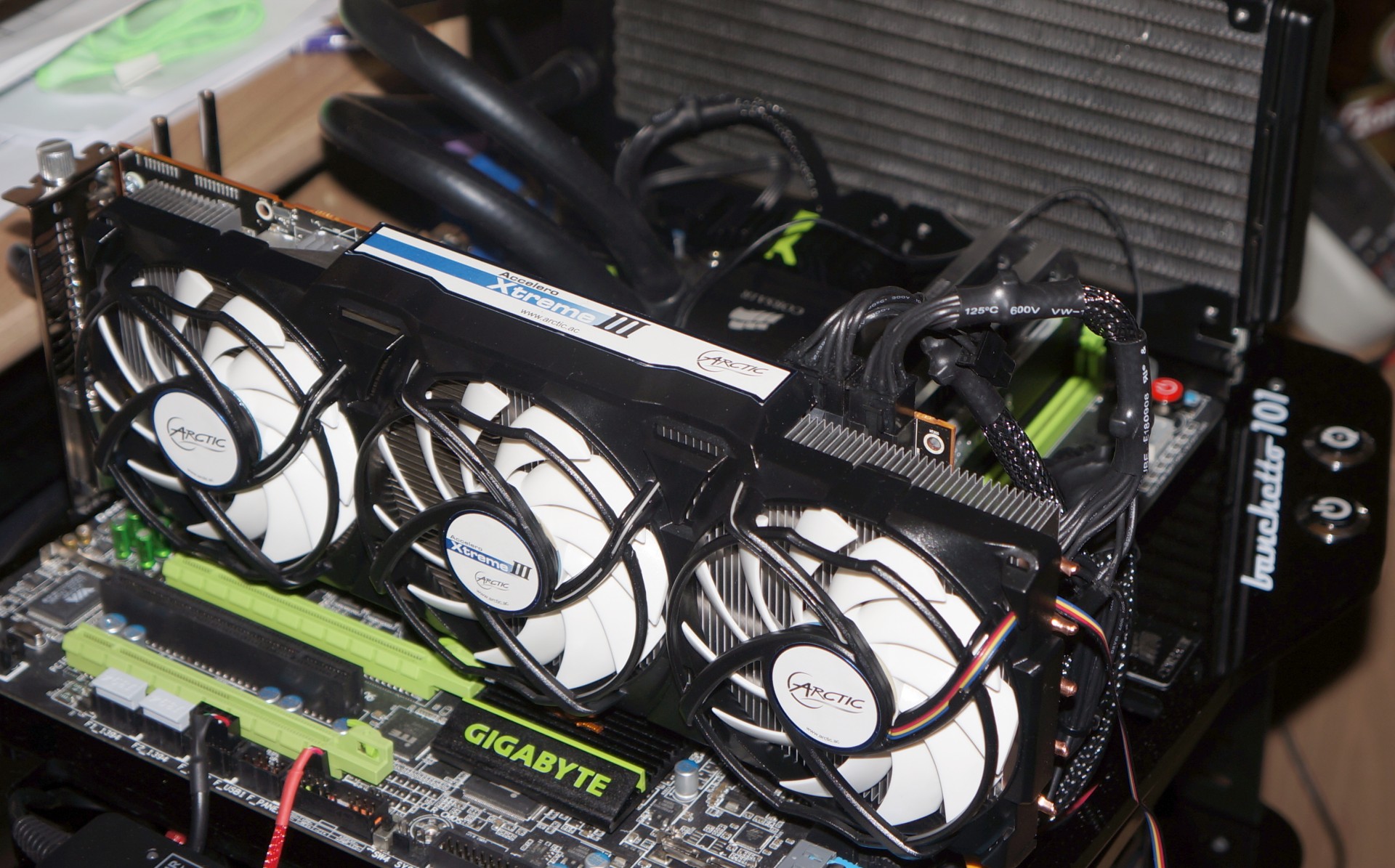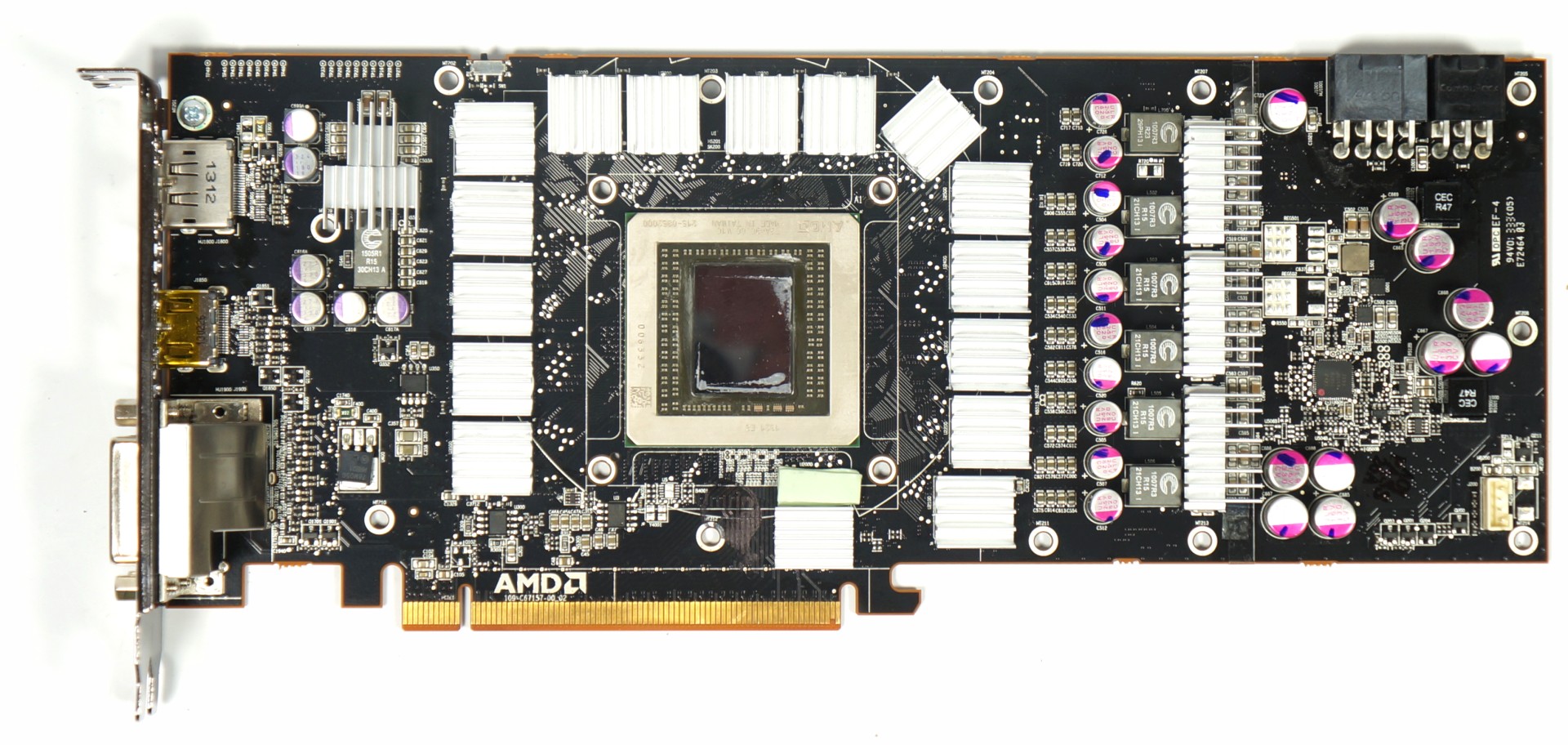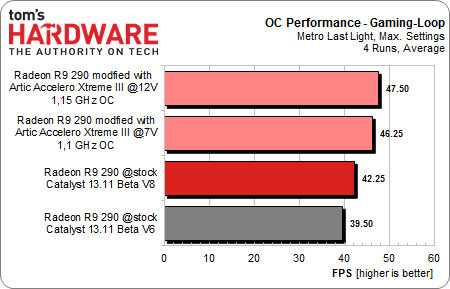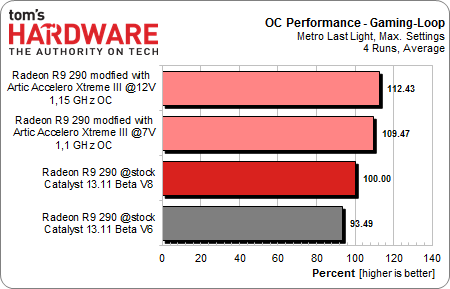AMD Radeon R9 290 Review: Fast And $400, But Is It Consistent?
We have all the makings of a dramatic launch: new high-end hardware, a last-minute delay for more performance, a crazy twist based on retail hardware, and our own home-baked solution to AMD's noise problem. Does Radeon R9 290 impress us or fall short?
Do-It-Yourself Upgrade With Arctic's Accelero Xtreme III
Replacing the Reference Cooler with Arctic's Accelero Xtreme III
The Arctic Accelero Xtreme III, now in its third iteration, can keep pretty much anything cool. This is the type of heat sink and fan combination that kept the overclocked Fermi-based Sparkle GeForce GTX 480 from melting not just itself, but half the computer. It does fit the Radeon R9 290 with minor modifications and can thus serve us as an example of what AMD could have done with this card. We’ll publish the entire upgrade as a guide soon, since it was really, really worth it.
Overclocking Results
We’re using the same gaming loop as before, trying to pinpoint the card's maximum clock rate through a series of small increases. The Arctic Accelero Xtreme III can be controlled via PWM or run with a constant voltage and RPM. The OverDrive applet's new fan control changes the game, though. Maximum fan speed is now bound to the target temperature. It doesn’t make sense to set this target to the 50 or 60 °C that are possible with this cooler just to have it spin slightly faster. That kind of setup is essentially self-limiting due to its (too) good cooling performance. Even under a full load, it’s almost impossible to get the Arctic Accelero Xtreme III to spin at more than 20 to 25 percent by changing the driver settings. This isn’t enough to provide cooling to the voltage converters.
Consequently, we went with the direct connection and a fixed voltage. Even at 7 V, the upgraded Radeon R9 290 is barely louder at prolonged full load than the stock versions are at idle, and the GPU and VRMs stay cool to boot.
Let’s take a look at the benchmark results of the overclocked Radeon R9 290, which turn out to be a big surprise. There’s a 20 percent difference between the original card and the overclocked one. The updated last-minute driver reduces this difference to a still-massive almost-13 percent. Keep in mind that we’re not just talking about a frequency increase, but also more usable performance and less noise. The Arctic Accelero Xtreme III demonstrates nicely what can be achieved with AMD's Radeon R9 290.
Video Comparison between the Reference and Third-Party Cooler
The first two videos show the AMD Radeon R9 290 with the Arctic Accelero Xtreme III at 12 and 7 V, respectively. The third one shows the original stock version of the card.
Bottom Line
If anything deserves an award, it’s the Arctic Accelero Xtreme III third-party cooler that lets AMD's Hawaii-based boards realize their potential. This is how the card could, and should, perform. Why AMD persists with its sub-par cooling solution is really anyone’s guess, especially since these problems have been going on for years. Dumping the issue on its partners can’t really be the solution either, since a graphics card’s reputation is made, or lost, on launch day.
As long as the only reaction to this is a driver update with questionable benefits, the reference graphics cards will always be the cheap solution. This GPU deserves better. As we said before, we’ll post the upgrade guide as its own story, since none of AMD’s partners currently offer their own PCBs and cooling solutions.
Get Tom's Hardware's best news and in-depth reviews, straight to your inbox.
Current page: Do-It-Yourself Upgrade With Arctic's Accelero Xtreme III
Prev Page Noise And Video Comparison Next Page Radeon R9 290: Priced Right Where We’d Peg It-
slomo4sho This is a win at $400! Good job AMD!Reply
http://techreport.com/review/25602/amd-radeon-r9-290-graphics-card-reviewed/9
11865199 said:However, the two retail Radeon R9 290X boards in our lab are both slower than the 290 tested today. They average lower clock rates over time, pushing frame rates down. Clearly there’s something wrong when the derivative card straight from AMD ends up on top of the just-purchased flagships. So who’s to say that retail 290s won’t follow suit, and when we start buying those cards, they prove to underperform GeForce GTX 780? We can only speculate at this point, though anecdotal evidence gleaned from our experience with R9 290X is suggestive.
Chris, these results differ drastically from real world results from 290X owners at OCN... I understand that your observations are anecdotal and based on a very small sample size but do you mind looking into this matter further because putting such a statement in bold in the conclusion even though it contradicts real world experiences of owners just provides a false assumption to the uninformed reader...
The above claim has already escalated further than it should... A Swiss site actually has already rebutted by testing their own press sample with a retail model and concluded the following:
With the results in hand, the picture is clear. The performance is basically identical between the press copy and graphics card from the shelf, at least in Uber mode. Any single frame per second is different, which is what may be considered normal as bonds or uncertainty in the measurements.
In the quiet mode, where the dynamic frequencies to work overtime, the situation becomes slightly turbid. A minor performance difference can be seen in some titles, and even if it is not about considerable variations, the trend is clear. In the end, it does an average variance tion of only a few percent, ie no extreme levels. The reason may include slightly less contact with the cooler, or simply easy changing ambient temperature. -
Heironious This is weird, something must be wrong with your system. I have an i5-2500, GTX 780, 16 GB G Skill 1333, 500 GB samsung SSD, Windows 8.1 64 bit, and on Ultra with 4x MSAA I get 80 - 100 FPS....Reply -
Heironious Multiplayer would add more stress to the CPUs / GPU's. Like I said, something is wrong with their machine. I would prob get higher on single player. Im going to check and find out.Reply -
slomo4sho Reply11865222 said:According to Tom's Benchmarks Nvidia's price drop just became meaningless
Now to wait for the non-reference cards at the end of the month! -
jimmysmitty I agree that the stock cooling is pretty bad but in honesty, no matter how nice they make it after market is always better. The Titan may not have had after market but if it did it would have cooled better.Reply
It looks like a good card for the price as it even keeps up with the $100 more GTX780. This is good as NVidia may drop prices even more which means we could also see a price drop on the 290X and I wouldn't mind a new 290X Toxic for sub $500. -
guvnaguy In terms of potential performance it seems like a great card, but you get what you pay for with regards to chip quality and cooling.Reply
Best to wait a month or two before buying to see how this all goes down





